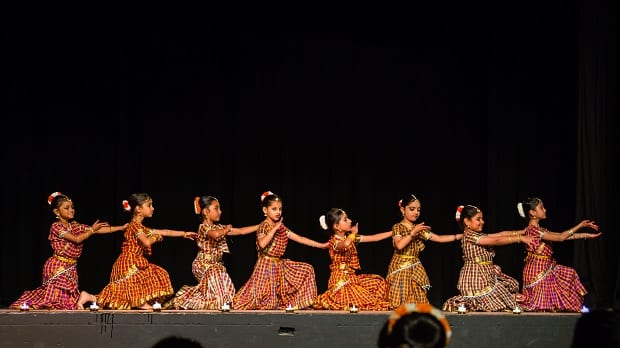Through the guidance of Hamsa Venkat, students express their creativity in classical Indian art forms, writes DEEPA GOPINATH

In this hectic modern-day world, a creative outlet is not only helpful, but necessary as a stress reliever. Whether it is the visual arts, music, dancing or any other artistic endeavour, when we lose ourselves in an art form, everything else fades away.
Hamsa Venkat, through the Samskrithi School of Dance, gives dancers the gift of a creative outlet. A talented dancer in her own right, Hamsa trains and nurtures her students in the South Indian dance form of Bhrathanatyam, while juggling a job as an English teacher and caring for her own family. Despite her other commitments, passing on the knowledge of the art form is something very dear to her heart. Learning such a structured art form brings with it the joy of creativity, but also other life skills such as confidence, discipline and social skills.
In addition to regular classes, students perform in at least one of the school’s bi-annual concerts. The first of these for the year is geared towards providing junior students with the on-stage confidence and exposure they need to blossom into performing artists. Participation in these shows is an important part of a dancer’s development. “Performance is a commitment and it drives students to improvement,” according to Vidhya, who has been learning with Samskrithi for the past eighteen months.
The joy that comes with learning this elegant art form shines from the faces of Vidhya and her classmates, Bhavani and Manju. All three are mothers of young children who moved to Sydney from India, as newlyweds. The three have in common the fact that they learnt Bharathanatyam in their home country more than fifteen years ago. They have sustained their love of the art form through the years, but never did they imagine that they would have the opportunity to not only learn again, but to perform in Australia. Dance has given them the gift of a sense of self, and an opportunity for personal achievement outside of their careers and family commitments.
For the younger students, the enjoyment of dance has a simpler, but equally significant basis. Sahana (10) learns Carnatic music and another dance form, Kuchipudi, as well as Bharathanatyam. She values the exercise and athleticism that comes with learning dance. Having learnt dance since she was 6, the opportunity to learn and perform a diverse repertoire is something that Sahana appreciates in Hamsa’s style of teaching.
Varsha (13) attends class with her sister Jyothi and they hope to perform their arangetram (solo debut performance) together one day. In a very mature way, she explains that there are limited opportunities for exposure to Indian culture in Australia (compared to India), and dance is one way in which they can connect with their culture. Through dance, the girls have learnt much about Hindu mythology. After all, natya, or the act of storytelling, is one of the main aspects of Bharathanatyam. Hamsa makes great efforts to explain each story they are enacting to her students, making it easier for them to be expressive through dance.
Varsha and Jyothi’s mother Madhu agrees that the discipline provides her girls with focus and promotes pride in their culture. They not only enjoy a creative outlet outside of school, but have the chance to make long-lasting friendships within the community. Madhu adds that Hamsa has a way of drawing the best out of her students, one of the qualities that makes her a wonderful teacher.
And like many teenage girls, when asked what is her favourite part of performing, Varsha’s reply is “the costumes!”
What makes this annual production unique is the involvement of young musicians, many of them senior students of Samskrithi School of Dance. Devika, a talented dancer and vocalist, was part of the musical line-up. Being a dancer allows her to more effectively lend her silken voice as an accompaniment to the dancers, and she considers herself blessed to have the opportunity to be involved in so many aspects of this beautiful art form. One of the challenges of singing for dance is the need to follow a specific structure that accompanies the choreography. Through her own dedication, her mother’s tutelage as well as the methodical approach of Hamsa, Devika is emerging as one of Sydney’s most talented young classical dance vocalists.
Each year, many other senior students of Samskrithi also pitch in to help keep the order backstage, ensuring the show runs as smoothly as possible. This collaboration between the Guru, dancers, senior students, other artists and parents of the dancers is what makes Parampara such a success! The role that such opportunities play in building a young artist’s confidence is invaluable, and the satisfaction it brings to all involved is beyond measure. Dance is a without doubt a creative outlet but it is so much more. As Hamsa Venkat says, it is not only a representation of life, but it is life itself.
Guru, shishya, parampara

Reading Time: 3 minutes



